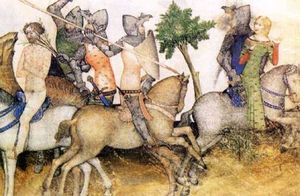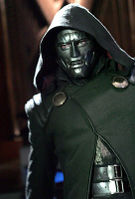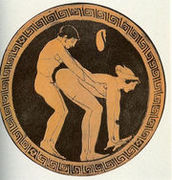Origins of Chivalry
“Chivalry is NOT dead...she’s chained to a pipe in the basement.”
| Famous Clients |
|
Contrary to popular belief, the chivalry with which we are familiar today was not born from idealism. Nor was it created for the purpose of protecting the weak from bullies with big swords. Rather, the origins of chivalry was an unexpected consequence of the exploits of Chivalry Hawkins, the medieval prostitute who unwittingly provided the foundation for abstract behavioral concepts we call “Chivalry,” “Courtly Love,” and “Customer Service.” Her widespread popularity and social influence displeased the leaders of the Catholic church to the point that they initiated an epic campaign of disinformation designed to remove her from the history books, with the incidental side effect that it greatly informed the development and modern definitions of these concepts.
The Woman Who Inspired an Age[edit | edit source]
Chivalry Hawkins was a medieval noblewoman who had a serious penchant for armored guys on horseback. Daughter of the notorious English rebel Sir Hubert Hawkins and the Maid Jean, this amazing woman was born with a silver spoon in her mouth and raised amid the wealth and opulence of European nobility...which of course abounded with knights in very shiny armor, and their noble steeds.
After happily losing her virginity to several talented young knights in the hay loft of the royal stables (she’d been led there on the rather obvious pretext of an offer to play with their lances), Chivalry could not bear the thought of marrying some stuffy old lord and spending the rest of her days supervising servants, embroidering piles of handkerchiefs, and otherwise being boringly respectable...especially if it meant spending all her nights with just the one old fart guy. So, when those knights rode off to join the army for some war or other, she hid in the supply wagon packed up her belongings and went with them, thus beginning her career as a camp-following prostitute – an endeavor which resulted in nearly a thousand years of fame.
Despite the fact that she was fabulously wealthy, had all the knights she could want, and generally got to do exactly as she pleased – an uncommon circumstance for women of any that age – Chivalry eventually grew tired of following armies around, so she retired to the Banat region of Eastern Europe, near the Carpathian Mountains. There, she used her wealth and her way with men to found the small nation of Latveria. Unsurprisingly, the besotted populace quickly made her their queen.
In an effort to stave off boredom during her retirement, Chivalry collected a small harem of young, accommodating knights, who later became the founding members of the prestigious Latverian Queen’s Guard. Apparently qualifications for this honor haven’t changed much since the days of Queen Chivalry, as the two most important are still being hung like a good posture and the ability to "ride" through the night, should the need arise.
Cornerstone of Courtly Love[edit | edit source]
It is possible that Chivalry inherited her camp-following ways from her mother, who had, after all, spent time (ahem) “serving” in a rebel army – rumor has it that her specialty was playing the eternal virgin and that’s why she was called “the Maid Jean” even after getting married – but in any case, Chivalry was a natural who quickly gained fame and a devoted clientèle by impersonating otherwise unattainable noble ladies of England, France, Germany, Italy, New Jersey, and Spain.
This practice allowed many knights to endure the restrictions of worshiping said ladies from afar without having to suffer undue sexual frustration. It also inadvertently provided the foundation for a fad known as “courtly love.” Unbeknownst to most of the ladies on the receiving end of courtly love, it wasn’t that the men who spouted sonnets and mooned over them loved them in way that was literally pure and chaste and all that nonsense. They merely had Chivalry to rely upon if the true objects of their affections refused to put out remained unavailable.
It is said that Chivalry often used musical performances as a discreet means of initiating liaisons or stalling for time. This charming habit was apparently inherited from her father, who at one time was forced to pose as a famous court bard/jester. Interestingly, such performances became an integral part of the practice of courtly love and was later expected of any knight wishing to be thought truly “chivalrous” by their peers.
Is Chivalry Really Dead?[edit | edit source]
Chivalry’s popularity remained extremely high for several centuries, which should have raised a few eyebrows, but let’s face it, few knights are given to deep thought when confronted with a beautiful woman who is famous for her ability to fulfill one’s every sexual desire. However, the truth is that -- like Marie Laveau of New Orleans Voodoo Queen fame and the Dread Pirate Roberts, whose legend was popularized by the movie The Princess Bride -- although Chivalry Hawkins was the creator of the Chivalry persona, she was only the first to wear it. When she retired, Hawkins bequeathed the Chivalry mantle to her favorite apprentice, and that enterprising young woman became the second in a long line of Chivalrys whose legacy is still felt today.
The fact that there was more than one Chivalry was an open secret, but one that was soon forgotten. As Chivalry’s popularity continued unabated from generation to generation, this sowed considerable confusion, with the result that people still comment and joke about whether or not she’s really dead. Given her apparently unnatural longevity, there was even some speculation during England's Greek revival fad of the Victorian Era, that – since her legacy centers around romance and head games – she might have actually been a Greek nymph born from the union of Eros and Psyche, before Psyche’s elevation to goddess-hood. ...But that’s just silly.
Although the exact date has been lost, the death of the original Chivalry was reportedly witnessed by family members, as well as many servants and former clients, in the Latverian royal palace. Their oral tradition (no, not that kind. The kind where people share stories. Geez, get your mind out of the gutter, people!) states that at the auspicious age of 69, Queen Chivalry died, as she had lived...in bed. Whether one of her successors is currently continuing the Chivalry tradition somewhere out in the modern world is anyone’s guess.
Meet the Family[edit | edit source]
Chivalry's parents, Sir Hubert Hawkins and the Maid Jean, met while serving in the English rebel army, which had been assembled under the leadership of the infamous Blue Ferret to overthrow King Roderick the First. As reward for unspecified “services” in this army the Maid Jean was granted an honorary captaincy and allowed to run about in men’s clothing. For his part, Hawkins was a renowned tattoo artist, hired by the Ferret to counterfeit a royal birthmark on the derrière of the infant whom the rebels later placed on the English throne.
Despite being hale and hearty and pretty damned impressive with a sword whilst under hypnosis, Hawkins refrained from taking part in any actual fighting until the end of the rebellion, preferring to spend his time showing off the infant’s tattoo to prospective customers. However, being only a poor artist he couldn’t afford the Maid Jean’s usual fee, and Hawkins realized he would have to do something really amazing if he wanted to get into her well-fitted leggings. With this goal in mind, he impersonated “Giacomo, King of Jesters and Jester to the King,” a famous bard/jester recently returned from the Italian court. In this guise he gained entry to Roderick’s castle, managed to get himself knighted, and then opened the gates for the rebel invasion.
The Blue Ferret rewarded Hawkins richly for his part in placing the infant king on the throne, so the Maid Jean agreed to marry him and they quickly settled into a life of wealth and leisure. Their first daughter, Chastity, took a long time to conceive. Not much is known about her except that she was never very popular. The couple’s second daughter, Chivalry, was born soon after, but Sir Hubert was unable to sire any additional children due to damage incurred as a result his habit of wearing of all his tights several sizes too small. Chivalry and her sister did not lack for childhood playmates, however, as a host of previously unknown relatives turned up as soon as it became public knowledge that the Hawkins’ had money to burn.
In 1955, the story of Sir Hubert Hawkins and the Maid Jean, and their role in the overthrow of Roderick provided inspiration for the movie The Court Jester, starring Danny Kaye and Glynnis Johns.
Despite her family’s wealth and political connections, not to mention rumors that having her as a bedmate could keep one free of STDs and unwanted pregnancies, there is no record of Chastity ever getting married or having any children. In fact, it is well documented that, unlike her popular sister, women only pretended to like Chastity and men avoided her like the plague.
Although Chivalry Hawkins never married, she did have several children. Sadly, with only one exception, Chivalry’s descendants proved universally boring and unworthy of mention. The one exception is the current Latverian ruler, Victor Von Doom (aka Dr. Doom), who is quite the live wire. Thus far, he’s made several bids for world domination, with the goal of placing himself in a position where he could see his remarkable ancestress reinstated to her rightful place in the history books, and really make it stick. ...Now that’s dedication to family.
Identity Theft on a Grand Scale[edit | edit source]
So how did the name of a prostitute become a generalized concept and a term that represents an official idealized code of conduct for self-proclaimed good guys and heroes all over the world? This transformation was wrought by the Catholic church.
Leaders of the church had it in for Chivalry from the start. This was partly due to their unhappiness that so many knights and rulers were garnering an odd sort of prestige by allowing their names to be linked with a famous prostitute, but it was mostly out of spite. Chivalry preferred studly guys in armor and pretty much ignored the wimpy scholarly types in robes (see photo, left).
To get even, the church did what it always does when confronted with inconvenient people or facts – it engaged in a generations-long propaganda campaign dedicated to distorting the truth about Chivalry beyond recognition. And since the catholic clergy pretty much had a stranglehold on the Western European publishing industry until about the mid-15th century, there was no way to stop them. Thanks to their efforts, all modern mention of Chivalry pertains to a fictional idealized code of conduct, and the woman who inspired it has been virtually erased from history.
The Chivalry, or Chevalier: Chivalry Hawkins’ preferred client type (i.e., a single or group of knights). This is the origin of the term “’mounted’ knight.”
The Code of Chivalry[edit | edit source]
The hijacking of the Code of Chivalry was a brilliant move on the part of the Catholic church – one that had far-reaching effects.
As her fame grew, Chivalry routinely had more customers than could be serviced by just one woman, so she trained up a traveling brothel to take up the slack. Originally, the Code was two lists of rules of conduct. One to was be followed by all her girls and the other was for their clients. ...Sort of a combination of “No Shoes, No Shirt, No Service” and “How’s My Driving? Call 1-800-CHIVLRY,” with some common sense elements thrown in.
When one of her lovers, Charlemagne, took her lists to the printer (i.e., the local Catholic monastery), the sneaky priests rewrote them as a single list aimed at the knights and other heroic types (see below). For the most part, they simply adapted Chivalry’s mandates for their own needs, but where her rules defied translation into their unrelentingly boring Christian mores they either wrote the opposite or just made stuff up.
The priests wrote out 64,782 copies of the falsified Code of Chivalry, then used missionaries and bicycle messengers to distribute them all over Western Europe...as well as to the US Congress, where they were largely ignored. (Note: This was the first bulk mailing in recorded history. Its success is partly to blame for why people get so much crap in their mailboxes all the time.)
The falsified Code was embraced by all of Christendom and still influences behavior throughout most of what passes for Western civilization to this day.
Code of Chivalry, Originally for the Prostitutes[edit | edit source]
|
Code of Chivalry, Originally for the Knights[edit | edit source]
|
Chivalry Comes Full Circle[edit | edit source]
Despite the best efforts of the Pope’s propaganda machine to wipe out the memory of Chivalry Hawkins, the meaning of “Chivalry” has finally swung back around to being all about getting laid:
The Medieval Church-Created Ideal[edit | edit source]
From the 12th century onward chivalry came to be understood as a moral, religious and social code of knightly conduct. The particulars of the code varied, but codes would emphasize the virtues of courage, honor, and service. Chivalry also came to refer to an idealization of the life and manners of the knight at home in his castle and with his court.
(Excerpt from Wikipedia’s article on Chivalry)
Modern Chivalry[edit | edit source]
Originating in the early Middle Ages as a means of protection, chivalry today has evolved into a sort of dance that men do to get laid. Understanding where this practice came from is vital for the well being of your libido.
(Excerpt from Unencyclopedia’s article on Chivalry)





